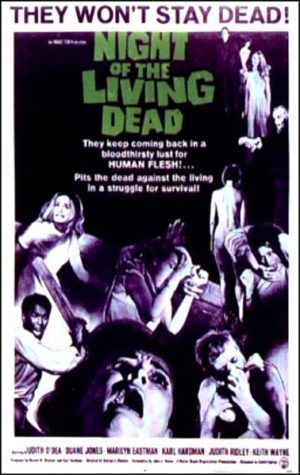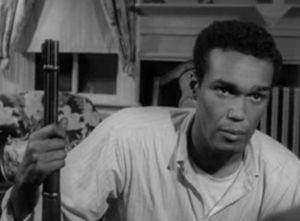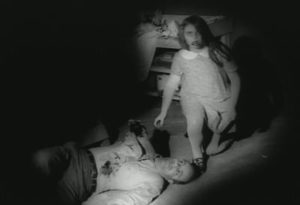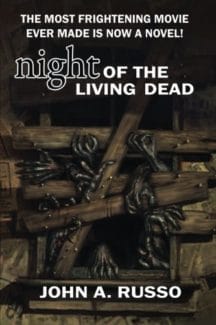 “They’re Coming to Get You Barbara!”
“They’re Coming to Get You Barbara!”
Author: John A. Russo
Night of the Living Dead, at first a collaborative movie effort between George A. Romero and John Russo, defines zombies as we now known them: predatory, cannibalistic, mysteriously animated, roving in hordes, and prone to spreading their unique bondage to death through bites. Many of us grew up with the black and white film from 1968 and learned to both fear and love the phrase, “they’re coming to get you Barbara.” Subsequent zombie entertainment culture has run with the transformation of zombies from the rare, mindless, mostly harmless creatures resurrected in Haitian voodoo lore to the bloodthirsty horde, for example: World War Z (the book – I’m not even going to deign to mention the travesty of a movie), The Walking Dead, and the subsequent Romero zombie films series – Dawn of the Dead, Land of the Dead, Return of the Living Dead, et.al plus all the comedy offshoots such as Shaun of the Dead and the promised Anna and the Apocalypse which is upcoming for the holidays. Fans of the Living Dead franchise will also remember with exceptional fondness the 1990 remake which boosted the catatonic Barbara into a feminist, kick-ass protagonist alongside the always strong and infinitely courageous character of Ben.
What’s special then about this adaption (i.e. pseudo novelization) of the original ’68 film is the fact that Russo, one of the two original screenwriters, adapts the actual screen play, following the chain of events and the unsettling vibe of the film expertly while going a level beyond and giving us what the big screen never can: insight into the characters. The graveyard, Johnny’s cannibalization, Barbara’s flight, and the farmhouse, later complimented by the arrival of Ben and eventually the Coopers, follows the story we know and love – the story that keeps us up at night staring into the dark corners of our rooms. But here, Ben and Barbara take on even more depth and we watch as our unprepared characters – average people not steeped in the modern day zombie lore or used to the idea of vast worldwide plagues (or even the AIDs epidemic, which would fall way later on the timeline) grapple with the horror of a world turned upside down. There’s no swashbuckling Rick Grimes, no precedent for the suddenness of an event that remains eerily inexplicable, no knowledge of what causes the dead (both recently and otherwise) to rise and consume human flesh, and no idea of how to survive.
In this way, the narrative follows an unprepared, dare I even say innocent, group of people, shattered by what they have seen and by the occasional rumor piped from unnerved television news anchors, through one night of attempted survival. The gore, the acute disgust that comes from watching people eaten alive, the unearthly silence and steadfast determination of the dead, and the formerly cozy farmhouse turned into an ill prepared, boarded up battle station has the same vigor, the same haunting clarity and sense of foreboding as on the screen. Yet now, we can hear Ben’s narrative, see the fracture lines forming behind the supposedly indomitable man who takes on the living dead and attempts to do the right thing along the way (protect others). Ben’s own inability to grapple with the truth, hidden from the outside, comes to life in these words and it amplifies the sense of hopelessness, the pervading sticky fear that has always coated this move, promoting it beyond B horror flick into a recognized classic.
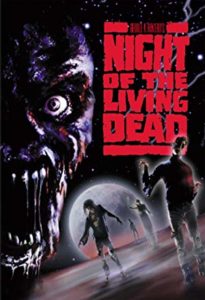
In the 1990 remake of Night of the Living Dead, Barbara’s character rivals Ben for front-row protagonist.
Even Barbara, an admitted annoyance in the ’68 movie (not to become likable until the 1990s) becomes more than a somnambulistic obstacle. To witness such events and be catapulted into a hell on earth reality would most likely make someone lose their minds and while we always knew this, here we can accept and sympathize with it. We see into Barbara’s shattered mind enough to evoke the question: how would I react? Perhaps we wouldn’t be the iconic Ben or even the loathsome Harry Cooper who manages to stay cognizant if not conscientious. If such a thing were to truly happen, if all ties of civilization and all simulacrums of safety were to dissolve, the world reverting to its inner bestiality, would we simply go inside our own minds to die? Could we help it?
And so the narrative minutely follows the movie while adding a new dimension. Only in the end, a moment of amplified action in the film, does the written story falter, proving that the sudden fast transition that was such a zenith on the big screen needs a little more care, a bit more attention and page space in book form. The long build, the creeping sense of something dead and clawed just around the corner, fractures under the burden of action not described, of a scene in the movie that imprints itself with horror but lacks something – the visual erosion of fake safety – in the novel. And so we end, and it is abrupt. Nevertheless, most of the spirit of the groundbreaking, innovative film is maintained and built upon. Fans can’t give this a miss: whether you’re a horror fan, a zombie fan, or just addicted to the films (’68 and ’90 respectively), this book captures the pioneering, creepy spirit of the Night of the Living Dead.
– Frances Carden
Follow my reviews on Twitter at: https://twitter.com/xombie_mistress
Follow my reviews on Facebook at: https://www.facebook.com/FrancesReviews/
[AMAZONPRODUCTS asin=”0692254536″]
- Book Vs Movie: The Shining - April 6, 2020
- Thankful For Great Cozy Mysteries - December 13, 2019
- Cozy Mysteries for a Perfect Fall - October 20, 2019


